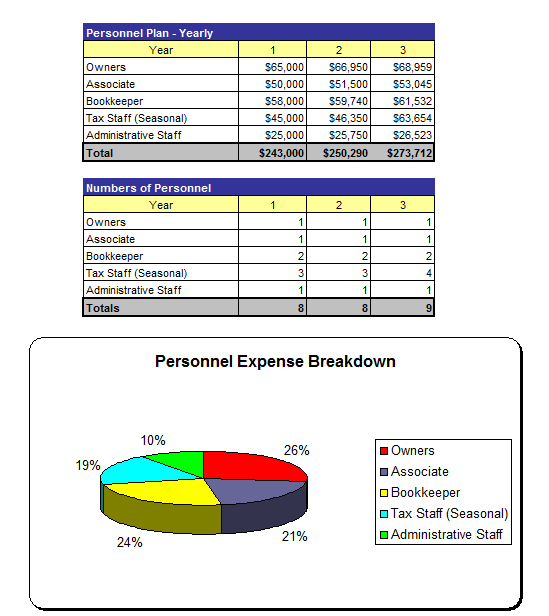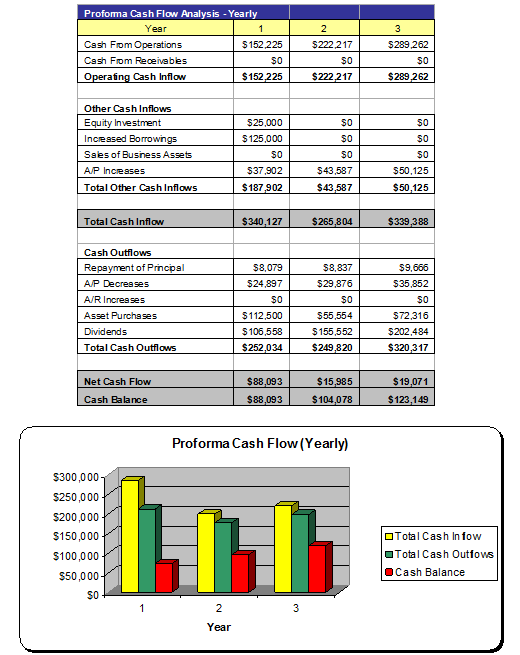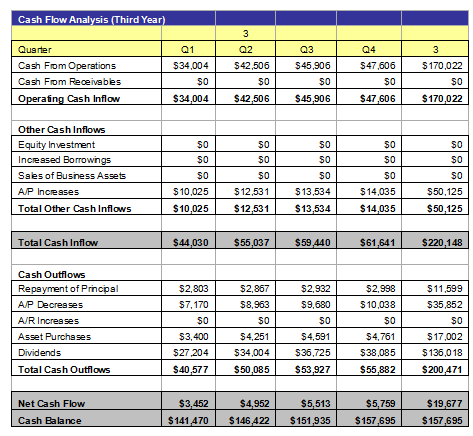Free School Bus Operator Business Plan
For Raising Capital from Investors, Banks, or Grant Companies!
Please note that the financials
in this complete free business plan are completely fictitious and may not
match the text of the business plan below. This free business plan demonstration
purposes only. If you are interested in purchasing the completed editable MS Word
and Excel documents for this business plan, please click the button below! Also,
the text of the business plan is formatted with a fully automated
table of contents.
Return to
Samples Page
It should be noted that there is no special software required to use these
templates. All business plans come in Microsoft Word and Microsoft Excel format.
Each business plan features:
- Excecutive Summary
- Company and Financing Summary
- Products and Services Overview
- Strategic Analysis with current research!
- Marketing Plan
- Personnel Plan
- 3 Year Advanced Financial Plan
- Expanded Financial Plan with Monthly Financials
- Loan Amortization and ROI Tools
- FREE PowerPoint Presentation for Banks, Investors,
or Grant Companies!
1.0 Executive Summary
The purpose of this business plan is to raise $200,000 for the development of a school busing service while showcasing the expected financials and operations over the next three years. School Bus Operator, Inc. (“the Company”) is a New York based corporation that will provide transportation services via its fleet of school busing municipal customers in its targeted market. The Company was founded by John Doe.
1.1 Products and Services
As stated above, School Bus Operator will be actively engaged in providing school bus transportation services to schools within its local market. The business will also be able to provide transportation services for large parties. At the onset of operations, Mr. Doe intends to have a fleet of three buses. The Company will price its services on per mile basis. The third section of the business plan will further describe the services offered by the School Bus Operator.
1.2 The Financing
Mr. Doe is seeking to raise $200,000 from as a bank loan. The interest rate and loan agreement are to be further discussed during negotiation. This business plan assumes that the business will receive a 10 year loan with a 9% fixed interest rate. The financing will be used for the following: • Development of the Company’s office location. • Financing for the first six months of operation. • Capital to purchase three school buses. Mr. Doe will contribute $25,000 to the venture.
1.3 Mission Statement
School Bus Operator, Inc.’s mission is to become the recognized leader in its targeted market for school bus transportation services.
1.4 Mangement Team
The Company was founded by John Doe. Mr. Doe has more than 10 years of experience in the transportation industry. Through his expertise, he will be able to bring the operations of the business to profitability within its first year of operations.
1.5 Sales Forecasts
Mr. Doe expects a strong rate of growth at the start of operations. Below are the expected financials over the next three years.

1.6 Expansion Plan
The Founder expects that the business will aggressively expand during the first three years of operation. Mr. Doe intends to implement marketing campaigns that will effectively target municipal agencies that require school busing services.
2.0 Company and Financing Summary
2.1 Registered Name and Corporate Structure
School Bus Operator, Inc. The Company is registered as a corporation in the State of New York.
2.2 Required Funds
At this time, School Bus Operator, Inc. requires $200,000 of debt funds. Below is a breakdown of how these funds will be used:

2.3 Investor Equity
Mr. Doe is not seeking an investment from a third party at this time.
2.4 Management Equity
John Doe owns 100% of School Bus Operator, Inc.
2.5 Exit Strategy
If the business is very successful, Mr. Doe may seek to sell the business to a third party for a significant earnings multiple. Most likely, the Company will hire a qualified business broker to sell the business on behalf of School Bus Operator, Inc. Based on historical numbers; the business could fetch a sales premium of up to 4 times earnings.
3.0 Products and Services
Below is a description of the transportation services offered by the Company.
3.1 School Bus Services
The primary revenue center for the business will come from providing school busing services to municipal agencies and private schools within the Company’s target market. As stated in the executive summary, Management intends to acquire three buses from the onset of operations. Mr. Doe has already begun to source contracts with municipal agencies as well as private schools so that the Company can have revenues from the onset of operators.
4.0 Strategic and Market Analysis
4.1 Economic Outlook
This section of the analysis will detail the economic climate, the school busing transportation industry, the customer profile, and the competition that the business will face as it progresses through its business operations. Currently, the economic market condition in the United States is moderate. The meltdown of the sub prime mortgage market coupled with increasing gas prices has led many people to believe that the US is on the cusp of a double dip economic recession. This slowdown in the economy has also greatly impacted real estate sales, which has halted to historical lows.
4.2 Industry Analysis
Outsourced school bus operations provide over $2 billion dollars a year to the general US economy. The industry employs more than 27,000 people, and provides annual payrolls that exceed $600 million dollars per year. The growth rate of this industry has remained in step with that the general growth of the country’s GDP. Management feels that by maintaining a wide range of municipal contracts, the Company can continue to generate revenues despite the current deleterious economic conditions in the United States. The average school bus service has 9 employees and grosses $600,000 per year in revenue.
4.3 Customer Profile
Municipal Agencies and Private Schools • Requires local transportation for children to school facilities. • Annual revenues exceeding $1,000,000+ per year. • Will spend $200 to $250 per day on local school bus services. Individual Customers • Annual household income exceeding $60,000 • Male or female between the ages of 35 and 65 • Will spend $100 to $200 for large scale transportation services.
4.4 Competitive Analysis
This is one of the sections of the business plan that you must write completely on your own. The key to writing a strong competitive analysis is that you do your research on the local competition. Find out who your competitors are by searching online directories and searching in your local Yellow Pages. If there are a number of competitors in the same industry (meaning that it is not feasible to describe each one) then showcase the number of businesses that compete with you, and why your business will provide customers with service/products that are of better quality or less expensive than your competition.
5.0 Marketing Plan
School Bus Operator, Inc. intends to maintain an extensive marketing campaign that will ensure maximum visibility for the business in its targeted market. Below is an overview of the marketing strategies and objectives of the Company.
5.1 Marketing Objectives
5.2 Marketing Strategies
Foremost, Management intends to maintain a broad based marketing campaign that will target municipal agencies that require school busing services. The business will regularly bid on contracts that are offered by municipal agencies that are located within a 50 mile radius of the Company’s location. The business will directly reach out to private schools so that the business can develop ongoing contracts with these institutions. Management anticipates that private schools will pay $200 to $300 per day on providing these services.
5.3 Pricing
In this section, describe the pricing of your services and products. You should provide as much information as possible about your pricing as possible in this section. However, if you have hundreds of items, condense your product list categorically. This section of the business plan should not span more than 1 page.
6.0 Organizational Plan and Personnel Summary
6.1 Corporate Organization

6.2 Organizational Budget

6.3 Management Biographies
In this section of the business plan, you should write a two to four paragraph biography
about your work experience, your education, and your skill set. For each owner or
key employee, you should provide a brief biography in this section.
7.0 Financial Plan
7.1 Underlying Assumptions
-
• School Bus Operator, Inc. will have an annual revenue growth rate of 16% per year.
-
• The Owner will acquire $200,000 of debt funds to develop the business.
-
• The loan will have a 10 year term with a 9% interest rate.
7.2 Sensitivity Analysis
The Company’s revenues are sensitive to many external factors. Should the cost of oil increase significantly, Management fully expects that its bottom line income will decrease. However, School Bus Operator, Inc. has priced its services so that moderate increases in the price of oil will not severely impact the Company’s ability to operate both profitably and cash flow positive. In the event of a dramatic increase in price, Management will seek to increase the price of its transportation services to reflect the higher transportation costs.
7.3 Source of Funds

7.4 General Assumptions

7.5 Profit and Loss Statements

7.6 Cash Flow Analysis

7.7 Balance Sheet
 .
.
7.8 General Assumptions

7.9 Business Ratios

Expanded Profit and Loss Statements




Expanded Cash Flow Analysis



